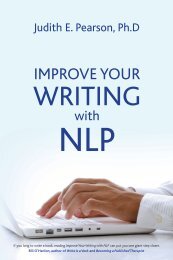Nigel Holt and Rob Lewis - Crown House Publishing.
Nigel Holt and Rob Lewis - Crown House Publishing.
Nigel Holt and Rob Lewis - Crown House Publishing.
You also want an ePaper? Increase the reach of your titles
YUMPU automatically turns print PDFs into web optimized ePapers that Google loves.
DATA ANALYSIS AND REPORTING INVESTIGATIONS | 25Type 1 <strong>and</strong> Type 2 errorsAfter you have carried out some statistical tests,you must decide whether you accept or reject thenull hypothesis. There are two major errors thatcan be made when doing this. These are describedrather confusingly as type 1 <strong>and</strong> type 2 errors.Type 1 errorThis is also known as the ‘false positive’ error. It isthe mistake of rejecting the null hypothesis whenit is actually true. You have made the decision toaccept your hypothesis by mistake. A very strictalpha value makes this kind of mistake less likely.Type 2 errorThis is also known as the ‘false negative’ error.This is the mistake of accepting the null hypothesiswhen it is in fact false, <strong>and</strong> you should haverejected it in favour of your hypothesis. A verystrict alpha value makes this kind of mistake morelikely.Do not underestimate the importanceof learning about probability, significance,<strong>and</strong> type1/type 2 errors! Theyare a crucial aspect of data analysis <strong>and</strong>you can bet that they will feature frequentlyin exam questions!Choosing the correctstatistical testThe choice of your test is influenced by the type ofresearch you have done, <strong>and</strong> the type of measurementsyou have made.Levels of measurementThere are three types of measurements you canmake in psychological research. These are nominal,ordinal <strong>and</strong> interval. The best way to describeeach is with an example.Nominal levelIf you have nominal data you have data that canbe classified in categories. By this, we mean thatif something is in one category it cannot be inanother category also. For instance, if you arecounting up the number of men <strong>and</strong> women ata rugby match, you cannot have someone whocounts as a man <strong>and</strong> also as a woman. Similarly, ifyou make a trip to a safari park to carry out a surveyon animals you may want to count the numberof monkeys you see <strong>and</strong> the number of hippos.You cannot have a monkey that is also a hippo –they exist as discrete categories. If your data is likethis, it is described as nominal level data.Ordinal levelThe clue for this one is in the name. Ordinalsuggests that there is an order. Horse racing is agood example. Horses are recorded as finishingfirst, second, third, fourth <strong>and</strong> so on. The order inwhich they finish is the important thing, not thedistance between them. If your data is like this, insome kind of order or rank, then it is described asordinal level data.Interval levelIf you are measuring something on a scale,perhaps the height of something or the time ittakes someone to do something, then you areusing an interval scale. Time, temperature, weight<strong>and</strong> height are all examples of interval levels ofmeasurement.A knowledge of your experimental design <strong>and</strong>the level of measurement used will allow you toanswer three simple questions, which will lead youto the appropriate statistical test.Example 1Our research is concerned with the relationshipbetween a person’s level of sadness <strong>and</strong> theamount of chocolate they eat. Here we are measuringsadness ratings <strong>and</strong> volume of chocolateconsumed in 10 different people.Question 1: Do I have correlation data?The answer to this is YES. You are looking for arelationship between variables <strong>and</strong> so your choiceof test is the Spearman’s Rho.Example 2Our research is concerned with investigatingwhether males are better at science subjects thanfemales. We collect science test scores from 10males <strong>and</strong> 10 females <strong>and</strong> want to compare them.Question 1: Do I have correlation data?The answer here is NO. You are looking atdifferences.Question 2: Am I looking at numbers incategories?The answer is NO. You are looking at differences.Question 3: What type of design did I use?The answer to this is an independent samplesdesign. You have two groups, one male <strong>and</strong> onefemale. A comparison is made of the scores of differentparticipants in the different conditions. Thetest for you is the Mann-Whitney Test.Extract from A2 Psychology: The Student’s Textbook © <strong>Nigel</strong> <strong>Holt</strong> <strong>and</strong> <strong>Rob</strong> <strong>Lewis</strong> ISBN: 9781845901004 www.crownhouse.co.uk

















